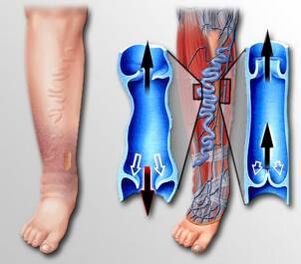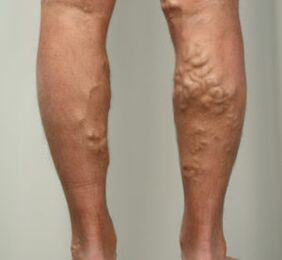
Varicose veins of the lower extremities - the appearance of spider veins (webs) and varicose veins on the legs. The disease, which is widespread in the elderly population, is more common in women than in men.
The disease received this name when translated from Latin, literally means: bloating, enlargement.
The first sensations with this disease are very different for each patient, but the feeling of heaviness in the legs, rapid fatigue, pain in the length of the vein unites everyone.
Treatment should be chosen by an experienced physician who can objectively assess the stage and development of the disease.
The pathology, which is often only a cosmetic defect, however, in some cases can lead to serious complications and permanent damage.
What is varicose veins, the mechanisms of pathology development

Some people after the age of 40 can face a rather unpleasant situation - the appearance of varicose veins in the legs. The small purple vessels that penetrate the skin, woven into cobwebs or resembling densely branched wood, are a serious cosmetic problem for many, especially women. "Out of nowhere" vascular networks (in medicine the term telangiectasia is used) is the expansion of small veins with a diameter of less than 1 millimeter, located in the thickness of the skin. This is one of the signs that a person has varicose veins in the legs.
If the nodules begin to protrude above the surface of the skin, soft to the touch, which become more noticeable when standing, then we can talk about another manifestation. This is already a more serious pathology - varicose veins of the great and small subcutaneous vein, as well as their branches.
The veins in the legs are soft, thin-walled channels that return blood to the heart. To counteract the force of gravity, nature has provided them with valves that prevent the reflux of blood. There are two venous systems in the lower extremities: superficial and deep. The first is represented by the vessels that are under the skin so that they can be seen. The second is the deep veins of the legs, located next to the bones in the thickness of the muscles. There are communications between these systems - perforating veins.
The inability of the valves to perform their function leads to stagnation of blood in the lower parts, ejection of its "excess" through the perforating veins from deep to superficial. This in turn creates increased pressure in the venous system of the legs located under the skin. causing her vessels to respond to this is "twisting and lengthening. "And that's why varicose veins appear in the legs.
Reasons for development
There are many conditions that lead to valve damage and loss of elasticity in the vessel wall. There are crucial causes of varicose veins in the legs, which are most often associated with this disease:
- Age. Over the years, our veins lose their elasticity and begin to dilate. The valves also "rough", lose elasticity and cease to perform their function normally.
- Pregnancy is accompanied by an increase in the volume of blood in the body, and also helps to slow its movement in the lower extremities (the large uterus compresses the veins of the small pelvis). Changes in hormone levels during pregnancy also play a role. As a rule, the symptoms of varicose veins without treatment resolve within 12 months after birth.
Acquired telangiectasias (or, as many doctors incorrectly call them, capillary varicose veins), the causes of the appearance of the face and legs are often associated with exposure to solar radiation. Therefore, women who want to avoid this cosmetic problem should choose - or a beautiful complexion, or a vascular network.
Risk factors
Varicose veins are a multifactorial pathology.
- Floor. Women are more likely to develop this disease. Hormonal imbalances that occur during pregnancy, premenstrual periods, and menopause can be considered a risk factor because they relax the venous wall for a long time. Hormone replacement therapy or long-term use of birth control pills also increases the risk of "getting" varicose veins.
- Heredity.
- Obesity.
- Prolonged standing or sitting (office workers, surgeons, drivers).
- Alcohol abuse. Alcohol and varicose veins also have a connection.
Symptoms and diagnosis
At first, the disease may not cause any discomfort, it may be suspected when the following symptoms occur:
- the formation of spider veins, webs on the legs (dilation of intradermal vessels of pink, blue, purple);
- the veins "twist", protruding above the surface of the skin, like ropes broken by knots.
The following symptoms may join later:
- tired legs;
- burning, throbbing, muscle cramps and swelling of the lower extremities;
- worsening of the manifestations of the disease if a person is in an upright or sitting position for a long time;
- itching around "swollen" vessels;
- varicose veins;
- painful, local hardening at the site of the vessel;
- skin discoloration or ankle ulcers.
The disease is diagnosed on the basis of data obtained during the examination and questioning of the patient. To assess the severity of the pathology (how the valves function, the presence of a blood clot in the veins), Doppler ultrasound is usually sufficient.
Pathological treatment
If "varicose veins of the legs" are diagnosed, this does not mean that there is a need for a long stay in the hospital. Thanks to modern minimally invasive procedures, the pathology is usually treated on an outpatient basis.
Change your lifestyle or help yourself
There are several self-help methods that reduce the discomfort of varicose veins and help prevent further varicose veins. Here are some of them:
- Regular exercise. Move as much as possible. Regular walking is a great physical activity that can improve blood circulation in your legs. How much load will be optimal - you can ask your doctor about it.
- Constant control over your weight, the excess of which has a detrimental effect on the vessels of the legs. Do not forget about salt, whose excessive intake in the body causes fluid retention, which increases the load on the veins.
- Pay attention to what you are wearing. Low-heeled shoes, unlike high heels, make the musculo-venous pump of the feet work - the gastrocnemius muscle. Avoid wearing tight pants around the groin and waist, as this can disrupt blood flow.
- Keep your legs up as often as possible. To do this, several times a day, you need to take breaks and raise your legs above the level of the heart, for example, to lie down and place them on pillows.
- Avoid sitting or standing for long periods of time.
Compression therapy
Usually, the initial stages of varicose veins of the lower extremities are treated with compression stockings. External compression prevents swelling of the veins, which in turn improves the movement of blood through the vessels.
Additional treatments for a more serious situation
If the change in lifestyle and the use of compression stockings do not improve the symptoms, and also if the stages of varicose veins (subcompensation and decompensation) do not allow to cope with the pathology alone, the following treatment options come to the rescue:
- Sclerotherapy.The procedure, which does not require much anesthesia, is performed on an outpatient basis. The doctor injects a special substance (sclerosant) into the varicose veins that sticks to the walls.
- Foam sclerotherapy.Unlike the usual technique, in this technique the sclerosant is injected into a vein after mixing it with gas (usually air), which makes it possible to treat veins with a larger diameter.
- Laser surgery. . . The new technology, which removes small varicose veins and vascular networks, is performed without skin incisions and vascular punctures.
- Intravenous radiofrequency or laser ablation. . . A technique involving the insertion of a catheter into a lumen of a vein topped by a radio frequency or laser energy emitter.
- Safe-femoral ligature and removal of the great saphenous vein. . . The first procedure involves dressing and removing the upper vein. During the second, a special probe is inserted into the lumen of the vessel (two incisions are made in advance: one in the groin area, the second at the level of the upper third of the lower leg) and extends along its entire length. It is then removed along with the varicose vein.
- Outpatient phlebectomy. . . The doctor removes small varicose veins while making several micro-incisions in the skin. The scars are usually almost invisible.
- Endoscopic vein surgery. . . It is usually performed when the patient has an advanced stage of varicose veins of the lower extremities (ulcers appear) or, previous methods of treatment have been ineffective.
Varicose veins, which appear during pregnancy, usually disappear without any treatment within 12 months after birth.
Alternative medicine
There is a wide arsenal of alternative treatments for chronic venous insufficiency, a condition associated with varicose veins. The following means are most often used for this pathology:
- butcher's broom;
- grapes (leaves, juice, seed extract);
- horse chestnut;
- sweet clover.
Before using any herb or dietary supplement, you must make sure that these additional medicines are compatible with the medicines prescribed by your doctor and are safe for your specific situation. Therefore, you should consult your doctor before taking them.
Prevention
There is no universal, guaranteed way to prevent the development of varicose veins in the legs. However, there are preventive measures that help reduce the chances of getting new manifestations of the disease, to improve its symptoms. Here are some of them:
- Physical activity (regular sports where the legs are "on", such as walking or running, improve blood circulation in the lower extremities, strengthen blood vessels).
- Weight control (extra pounds increase the load on the lower extremities).
- Do not cross your legs while sitting.
- During rest, raise them above the level of the heart.
- Try not to stand or stand still.
- Diet (less salt and more fiber).
It is also worth rinsing your feet with cold water after a shower or bath. Try to visit baths or saunas less often.
Varicose veins of the legs are a common problem, the incidence in men varies from 10 to 20%, and in women it reaches 33%. Unfortunately, it is impossible to fully recover from this disease. But new minimally invasive techniques used in medicine can improve symptoms. Early treatment in the early stages of the disease can prevent the development of serious complications.




































